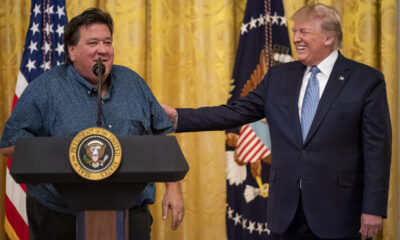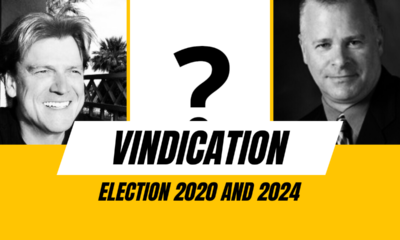Executive
Mail-in ballots have to go (election reform)

Data from at least two elections – Wisconsin in 2020 and Virginia in 2021 – show that mail-in ballots have a distinctive partisan tilt. In both these elections, mail-in ballots trended Democrat. And in Virginia we can distinguish between mail-in ballots and in-person early voting. The latter trended Republican across the State and in most counties, even while mail-in ballots trended Democrat. One can accept this as an occasional result but not as a consistent one. It could mean that those inclined to ask for ballots by mail tend to vote Democratic. Or it could mean that the Democratic Party deliberately manipulates mail-in ballots to try to win elections. Only one way exists to find out: eliminate mail-in ballots and replace them with some form of in-person election service. And if the results swing back to the norm, then we have established, and eliminated a cause of, fraud.
The Wisconsin and Virginia experience with mail-in ballots
Turn first to the Wisconsin experience. We have this report, in today from Buzz Bomb Media, that Wisconsin legislators are demanding certain answers about that experience. Republicans control the Wisconsin legislature – but Biden carried the State in 2020. But he almost didn’t. Buzz Bomb quotes The Milwaukee Journal-Sentinel thus:
Milwaukee County’s lump-sum contribution turned the race on its side. To that point, Donald Trump held a lead of 109,000 votes over Joe Biden, but once Milwaukee Country absentee and early-voting ballots were uploaded into the system, Biden took a lead of 11,000 votes.
Whiskey Tango Foxtrot!? The Wisconsin Assembly’s Committee on Campaigns and Elections suspects manipulation of the voter rolls. To give them further reason, the Center for Tech and Civic Life, with a big fat grant from Mark Zuckerburg, CEO of Facebook, became a de facto division of elections in Wisconsin.
That report does not distinguish mail-in ballots from in-person early voting. But Virginia does. Recall this report of how Glenn Youngkin led a three-person team to sweep the State. These returns from Hanover County, where your editor lives, tell the tale. Notice that Terry McAuliffe, the Democrat, carried mail-in ballots (labeled AB) by a 3-2 margin. Then notice that Glenn Youngkin, the Republican, carried in-person early voting (labeled EV) by a wider margin of 7-3. The Democrat also carried mail-in ballots that came in late (labeled PE), but by a bare majority. (And in any case, Hanover County received most of those ballots on time.)
The takeaway
One can see similar results by a spot check of counties and independent cities in Virginia. Hanover is one of the most conservative counties in Virginia. But neighboring Henrico County, now a liberal county, shows a similar skew in mail-in ballots.
One would expect Central Absentee Precinct results to be similar to the unit average, and in-person early voting to be similar to mail-in voting. Clearly this is not true. To test this, let us perform a Chi-Square test of statistical independence on Hanover County. To do this, we subtract the expected value of each vote count from the observed, square the difference, and divide by the expected value. We do this for each candidate, then sum all these values up.
To determine the expected value, assume that each candidate would get the same proportion of the mail-in vote as the total vote. So:
Candidate Observed (O) Expected (E) (O-E)2/E Youngkin 37.35 68.18 13.,94 McAuliffe 61.47 31.24 29.25 Blandings 0.99 0.52 0.42 Write-in 0.09 0.06 0.02 Sum 43.63
The probability that mail-in ballots just happened to fall out as they did in Hanover County, from a Chi-Square table with three degrees of freedom (that is, one fewer than the choices), is off-the-charts small. (If you doubt that, see the Chi-Square table for yourself.) When the probability falls below one chance in twenty, you reject the null hypothesis. Here the probability is less than one chance in a thousand. Therefore, something biases mail-in ballots.
What’s going on with these mail-in ballots?
Probability theory came from a group of noblemen who wanted to know their chances of winning at the roulette, baccarat, and other tables at the famous Casino Royale in Paris. Results like these would tell them that either:
- The game is inherently unfair, or
- Someone is cheating.
In this case, the Democratic Party would have you believe that mail-in ballots capture a demographic that a requirement for in-person voting would under-serve. Why, then, do they insist on expanding mail-in balloting for everyone? Why should they expect the results to be so strikingly different?
Unless – and this is what the Wisconsin Assembly Committee on Campaigns and Elections suspects – the Democrats are cheating. And in that event, they want to cheat. How can they cheat at mail-in ballots? Well, per the Center for Tech and Civic Life grant process, they suddenly control all aspects of absentee balloting. So even if, as apologists for mail-in voting assert, one prints ballots on special stock with unique codes, those codes are forge-able. And forge they have done. That is the simplest explanation that fits all the facts.
To stop this from happening, or even to find out whether it is happening, one must eliminate mail-in ballots.
But … but … how are they supposed to vote?
Ah, that’s where your editor’s newest invention, the Mobile Voting Precinct, comes in.

The Mobile Voting Precinct takes the place of mail-in ballots. It provides all the authentication you get with in-person voting. So if you can’t come into the precinct to vote, the precinct comes to you.
This removes all but the rarest excuses for not showing up to the polls on Election Day itself. And to accommodate those case, allow one week of in-person early voting. (Officers of Election assigned outside their precinct, anticipated business travel, things like that.)
College students can, if they wish, make a special trip by air, rail or automobile to their parents’ precinct. They would do this during in-person early voting. (But remember: if we re-up the Age of Voting Privilege to 21, that problem almost vanishes.)
Military voting presents a special case. Unless we are prepared to legislate that service members in uniform are not entitled to vote, the services should make the same effort to collect and count their members’ votes as they do to deliver their members’ mail to them. And that likely means making sure to collect those votes at the deployment point one month in advance. The Army, Fleet, and other Service Post Offices can then deliver the votes to the Central Special Voting Precinct in each unit in plenty of time.
Eliminate mail-in ballots and you eliminate these problems
What sorts of problems can we eliminate by sending the Mobile Voting Precinct and not sending mail-in ballots?
- A dead voter definitely will not vote anymore. The Mobile Voting Precinct will never record the vote of a ghost.
- Anyone even trying to vote in more than one precinct, through absentee balloting, will do it no more. Without mail-in ballots, he literally can’t do it.
- If a voter has a problem with his registration, the Mobile Voting Precinct can sort that out as easily as can the staff of a conventional precinct.
- You also eliminate the alleged problem of the Post Office not delivering mail-in ballots to voters, or to the Central Absentee Precinct, on time. The Mobile Voting Precinct offers same-day delivery as one of its many benefits.
Likely opposition
The Democratic Party surely knows that without mail-in balloting,
- Donald J. Trump would still be President, and
- The Georgia Senate delegation would have two Republican members, not two Democrat.
For that reason, they have teed up the John Lewis Voting Rights Act in the United States Senate. That act would:
- Eliminate photographic voter identification,
- Mandate voter registration on the very day of the election, and even
- Federalize and even bring into the White House the process of drawing districts for the House of Representatives.
All of which stands in violation of the Constitution, which is reason enough to oppose it.
And the best reason to eliminate mail-in ballots is that we have good reason to suspect manipulation. Statistical intervention is established because, as the Chi-Square assessment shows, the skew in mail-in results doesn’t just happen. Governing unit registrars owe it to their honest voters to eliminate the skew, or at least to make fraud impossible. This is as good a way as any to do it.
Terry A. Hurlbut has been a student of politics, philosophy, and science for more than 35 years. He is a graduate of Yale College and has served as a physician-level laboratory administrator in a 250-bed community hospital. He also is a serious student of the Bible, is conversant in its two primary original languages, and has followed the creation-science movement closely since 1993.
-

 Civilization1 day ago
Civilization1 day agoDC Pipe Bomb Arrest Raises Questions About Christopher’s Wray’s FBI
-

 Executive4 days ago
Executive4 days agoThe Last Supper: New York’s Socialist Feast
-

 Civilization4 days ago
Civilization4 days agoYoo Hoo, VP Vance—Your Character is Showing!
-

 Guest Columns3 days ago
Guest Columns3 days agoCongressional Leaders See Far Higher Stock Returns Than Peers
-

 Civilization2 days ago
Civilization2 days agoThe Legal Logic Behind U.S. Operations Against Narco-Terrorist Networks
-

 Civilization4 days ago
Civilization4 days agoFacing Facts & Rolling Back Mythologies: The New National Security Strategy
-

 Civilization3 days ago
Civilization3 days agoHow Trump Changed America
-

 Civilization5 days ago
Civilization5 days agoWaste of the Day: Senators Earmarked Cash for Their Former Schools











[…] votes. CNAV has shown by Chi-Square analysis that mail-in ballots skew […]
[…] By the way: the pathway to secure elections does not include hiring OOEs from temporary help placement agencies. But it might include refinements CNAV has suggested before, like the Mobile Voting Precinct. It also definitely includes getting rid of mail-in ballots. […]
[…] citizen to write to their representatives in the U.S. Congress and the U.S. Senate every day to insist on voter IDs and scrupulously monitored midterm […]
[…] everyone who cares to observe, can see that mail-in ballots skew left. Your editor showed that by running a Chi-Square test on last year’s governor’s race in Virginia. The left knows that mail-in ballots skew left, and […]
[…] vote by mail in numbers out of proportion to their registrations. CNAV has also shown that mail-in ballots skew Democrat in general elections. Governor Hogan vetoed an “emergency” bill that would have let election […]
[…] advanced a theory that mail-in ballots came in at about that time. Mail-in ballots, as CNAV has shown with a Chi-Square analysis of the Virginia 2021 Governor’s race, skew […]
[…] 1975, mail-in ballots have been illegal in France. France has started to introduce “machines” since 2002. But since […]
[…] for elections. Voting by mail, and unattended drop boxes, are part of that. And because mail-in ballots skew left, suddenly the Secretary of State does have duties of a confidential, policy-determining, […]